The Grandeur of Dubai's Largest Mosque
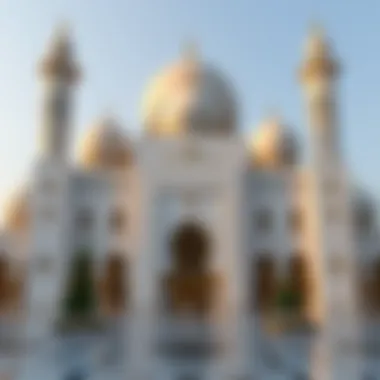

Intro
Dubai's largest mosque stands not just as a place of worship, but as a testament to architectural brilliance and cultural significance. It is a focal point in the emirate, drawing people from all walks of life. Designed to reflect the intricate details of Islamic architecture, the mosque features an array of stunning elements that highlight both tradition and modernity.
As we embark on this exploration of its grandeur, we will delve into various aspects, such as the architectural elements that define its beauty, its cultural impact on the local community, and its role within the broader context of Dubai’s commitment to maintaining its Islamic heritage. Moreover, this mosque is more than just bricks and mortar; it symbolizes a bridge between cultures, fostering interfaith dialogue and attracting a steady stream of visitors and tourists.
With so much to uncover about this architectural gem, let’s begin the journey through its majestic design and significant role in the heart of Dubai.
Prelude to Dubai's Largest Mosque
The largest mosque in Dubai stands tall as not just a place of worship but a striking symbol of the city's architectural prowess and cultural tapestry. As travelers and locals alike drift through the bustling streets of Dubai, it’s hard to miss this magnificent structure, drawing admiration and curiosity. In this section, we will embark on a journey to unveil the significance of this mosque in the realm of architecture, culture, and community.
Understanding the Icon
At first glance, the mosque captures the imagination with its grand structure. Its impressive domes and graceful arches reflect the deep-rooted Islamic architectural style while simultaneously embracing modern elements. This harmonious blend not only epitomizes the spirit of Dubai but also sets it apart as a beacon for inclusivity and dialogue. Visitors from various backgrounds find themselves captivated by the intricacies of the mosque's design. This structure is not just an architectural icon; it's a testament to the melding of tradition and innovation.
Further, the mosque offers insights into the values of serenity and spirituality, which are essential to the Islamic faith. It stands as a landmark not only for the dwellers of Dubai but for the entire region, fostering a sense of identity and pride among its inhabitants.
Historical Significance
Diving deeper into its historical roots, the mosque showcases a thought-provoking narrative about Dubai's evolution. This building symbolizes more than just a moment in time; it represents a journey that traces back to the city’s commitment to preserving its Islamic heritage amidst rapid modernization. The decision to construct such a significant place of worship speaks volumes about the leadership's intentions to provide spiritual solace and communal harmony in an ever-growing metropolis.
The mosque's inception laid the groundwork for a shift in the perception of spiritual spaces in urban settings. It has become a primary pilgrimage spot and plays host to thousands of worshippers daily. Furthermore, historical records and community memories bind people to the mosque, creating layers of meaning that deepen the visitor's experience. As such, it embodies both past and present, acting as a bridge between generations.
"The mosque is not merely an architecture marvel, but a living narrative of the community's faith and aspirations."
Architectural Design Features
The architectural design features of Dubai's largest mosque are not just artistic choices; they are reflections of the culture, history, and aspirations of the Emirati people. Each element has purpose and significance, deeply woven into the fabric of the mosque itself, enhancing its role as a center for worship and community engagement. This mosque represents a fusion of traditional Islamic designs with modern engineering, capturing the spirit of innovation that Dubai is known for.
Structural Elements
The structural elements of the mosque are a marvel of engineering skill. The use of reinforced concrete mixed with traditional materials like stone and marble illustrates a delicate balance between durability and beauty. The prayer hall is expansive, with a soaring ceiling supported by a series of intricately designed domes. These domes serve not just an aesthetic purpose but also play a critical role in the acoustics of the prayer hall, ensuring that the sound of the Imam’s voice reaches every corner.
There are numerous towering minarets that adorn the skyline, each engineered to ensure stability and withstand the desert winds. Their height not only represents a physical reach towards the heavens but also signifies the mosque's prominence within the community. The careful meticulous design considers factors like load-bearing capacities and seismic resistance, making the mosque not only a sanctuary but also a resilient structure.
Aesthetic Components
In exploring the aesthetic components, one can't help but marvel at the intricate detailing throughout. The mosque features elaborate tile work, with geometric patterns that tell stories of the past. The patterns are not random; they symbolize a connection to the divine, seamlessly integrating art with faith.
Moreover, the grand chandeliers, made from crystals, provide an enchanting glow, illuminating the interiors like stars in a night sky. The use of natural light is also thoughtfully integrated; large windows filter sunlight, creating a serene ambiance during prayer times. Visitors often find themselves captivated by the subtle elegance that fills the space. This interweaving of aesthetics with function is a hallmark of Islamic architecture, where beauty serves a purpose and elevates the spiritual experience for worshippers.
Landscaping and Surroundings
The landscaping surrounding the mosque is just as important as its architectural elements. It enhances the mosque’s magnificent presence, offering a tranquil space for the community to gather. Lush gardens and water features create a peaceful atmosphere, reminding visitors of the importance of nature and its relationship with spirituality. Palm trees sway gently in the warm breeze, casting shadows that dance on the ground.
Paths lined with ornamental flowers lead up to the entrance, guiding visitors and creating a sense of journey before entering the sacred space. The integration of local flora not only beautifies the area but also illustrates the commitment to sustainability, as native plants require less water and maintenance. This thoughtful landscaping reflects the mosque's role as a communal hub, inviting individuals to pause and reflect before they cross the threshold into worship.
"The mosque is not just a place of worship; it’s a bridge between tradition and modernity, connecting people to their heritage while embracing the future."


In sum, the architectural design features of Dubai’s largest mosque are crafted with purpose and intent. They embody the cultural identity of the Emirate, presenting a space that is both functionally profound and visually arresting. Through its structural integrity, aesthetic beauty, and surrounding environment, the mosque stands as a testament to the high aspirations and deep-rooted values of the society it serves.
Cultural Impact of the Mosque
The cultural impact of Dubai's largest mosque extends far beyond its imposing structure; it is a heartbeat of the community, a hub for cultural exchange and understanding in a rapidly evolving urban landscape. This mosque not only functions as a place of prayer but also immerses visitors and worshippers alike in the rich cultural tapestry of the emirate. Its influence reverberates through religious observances and educational programs, promoting tolerance, unity, and knowledge.
Religious Observances
Religious observances at the mosque play a crucial role in the cultural fabric of Dubai. Daily prayers and special religious ceremonies see a diverse mix of locals and tourists coming together in reverence. During important events like Ramadan, the mosque becomes a sanctuary for spiritual reflection. Thousands gather to break their fast and attend Tarawih prayers, showcasing a communal spirit that emphasizes togetherness and shared values. This congregational aspect fosters a profound sense of belonging among participants.
Moreover, the mosque facilitates various religious gatherings aimed at deepening the understanding of Islamic traditions. For instance, lectures on Quranic interpretations and guest speeches from esteemed scholars are regularly organized, contributing to a culture of continuous learning. This creates an environment where inquisitive minds can engage with Islamic teachings directly, bridging the gap between tradition and contemporary society. With an essence of hospitality, the mosque serves Arabic coffee and dates to attendees, embodying the traditional warmth of Emirati culture.
Educational Programs
The educational programs offered by the mosque are equally vital to its cultural impact. They cater not just to Muslims but also to those from different backgrounds who wish to understand Islam and its teachings. Programs like guided tours often include explanations about Islamic art, architecture, and historical significance, thus illuminating the cultural nuances associated with Muslim practices.
In addition, youth engagement initiatives aim to instill a sense of identity among younger generations. Workshops on the Arabic language, Islamic history, and etiquette are common, helping bridge the gap between cultural heritage and modern-day living. By investing in the education of the community, the mosque fosters an inclusive atmosphere that nurtures respect and understanding.
"A mosque is not just a place of worship; it's a center for social curiosity and growth, where everyone finds a space to learn."
The mosque’s influence reaches into interfaith dialogue, where discussions between Muslims and adherents of other religions are promoted. This commitment to fostering relationships through mutual respect amplifies its role as a cultural cornerstone in Dubai. Through these multiple facets, the mosque stands as a radiant beacon, lighting the path for community engagement and cultural enrichment in a diverse city.
This narrative of the mosque illustrates its invaluable role in the cultural landscape of Dubai, shaping community values and nurturing an informed society while upholding the core tenets of Islam.
Community Engagement
Community engagement plays a pivotal role in enriching the cultural landscape surrounding Dubai's largest mosque. It fosters a sense of belonging and ensures that the mosque is more than just a monumental structure; it becomes a living, breathing entity within the community. This engagement allows locals and visitors alike to connect deeply with Islamic traditions and values, helping to bridge cultural divides. By actively involving the community, the mosque not only enhances its relevance in today’s dynamic world but also promotes social harmony and understanding.
Supporting Local Initiatives
Supporting local initiatives is vital for the mosque, which seeks to strengthen ties with its surroundings. Various programs have sprung up that encourage communal participation, from organizing monthly food drives to setting up educational workshops on Islamic teachings and local customs. These initiatives empower residents, offering platforms to express their views and cultures, making them feel valued and included.
An example of such an initiative is the annual charity event held at the mosque, which invites local artisans to showcase their work. This not only helps to spotlight local talent but also fosters a spirit of collaboration within the community. Furthermore, partnerships with local schools emphasize awareness among younger generations, driving them to appreciate their heritage and the role the mosque plays in their lives.
By supporting local economies through these initiatives, the mosque demonstrates a commitment to the well-being of its community, which in turn nurtures loyalty and respect from the residents. In essence, these small efforts accumulate, creating an enduring impact.
Interfaith Dialogues
Interfaith dialogues are crucial in promoting mutual respect and understanding among diverse religious groups. The mosque actively engages in hosting discussions that bring people from different faith backgrounds together. These conversations focus on shared values such as compassion, integrity, and community service. By creating safe spaces for dialogue, the mosque provides an opportunity for individuals to ask questions, dispel misconceptions, and learn about the beauty and depth of Islamic faith.
In practical terms, these dialogues often include panel discussions featuring religious leaders from various traditions. Participants are encouraged to engage openly and respectfully, contributing to a richer understanding of each other’s beliefs. The mosque's role as an inclusive forum not only enhances its prestige but also helps cultivate an environment of tolerance within Dubai, making it a model for other communities.
"Tolerance, interfaith dialogue, and the human capacity for compassion will determine our future." - Kofi Annan
By championing such initiatives, the mosque positions itself as a symbol of peace and understanding, aligning with Dubai's aspirations to be a cosmopolitan hub. Through these efforts, it carves out a space where every voice is cherished, reinforcing the idea that unity in diversity is not just a lofty goal but a living reality.
Tourist Attractions Related to the Mosque
The mosque stands not only as a spiritual haven but also as a striking landmark that attracts a multitude of visitors each year. Tourists and pilgrims alike find themselves appreciating not just its grandeur, but the various attractions that surround it. This combination of faith and tourism significantly boosts Dubai's profile on the global stage, showcasing the city's cultural fusion.
Visitor Experience
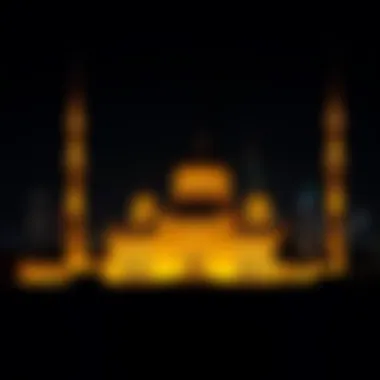
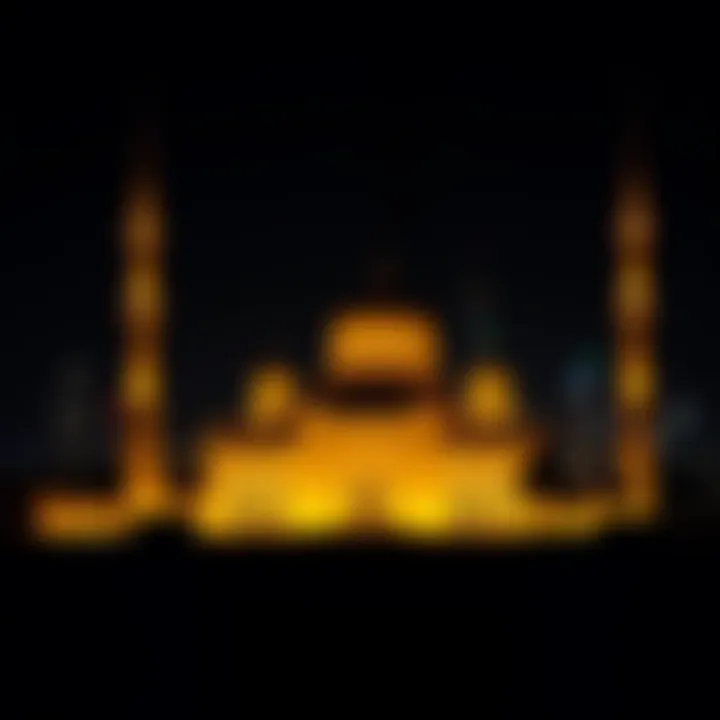
Visiting the mosque surely promises an unforgettable experience. Upon arrival, guests are greeted by vast open spaces that incorporate lush landscaping and elegant pools reflecting the mosque's majestic silhouette. The intricate architecture leaves even the most seasoned traveler awestruck. The calming atmosphere, complemented by the sounds of birds chirping, allows visitors to escape the bustle of city life.
Guidelines are laid out clearly to ensure respect for the site's sanctity.
- Dressing Appropriately: Visitors are reminded to wear modest clothes. Traditional attire is often offered at the entrance for those unprepared for the cultural norms.
- Photography: While personal photography is encouraged, visitors should be mindful not to capture images of worshippers engaged in prayer.
The mosque hosts a variety of events throughout the year, particularly during holy months like Ramadan, adding another layer to the visitor experience. Many attendees describe a palpable sense of peace upon entering the mosque, which is accentuated by an enthusiastic but respectful crowd.
Guided Tours and Activities
Guided tours offered at the mosque are particularly popular, blending history, culture, and architectural insights seamlessly. Knowledgeable guides lead guests through the mosque's expansive complex, detailing its various features and the meanings behind them. This blend of education and exploration provides attendees a richer understanding of Islamic traditions and values.
Activities and features of guided tours include:
- Informative Sessions: Guides often begin tours with a brief overview of the mosque’s history, explaining how it symbolizes Dubai’s commitment to Islamic values.
- Interactive Learning: Visitors can engage in Q&A sessions, making the experience dynamic and informative. Questions that arise during tours often lead to in-depth discussions about Islamic practices and art.
- Cultural Exhibitions: Occasionally paired with guided tours are exhibitions showcasing Islamic art and local history, giving attendees a broader context to appreciate the mosque within the Emirates' cultural landscape.
In summary, the mosque is not just a place of worship but also serves as a cultural hub that bridges the gap between locals and tourists. By encouraging visitors to learn, participate, and reflect, it boosts tourism while providing a meaningful representation of Islamic heritage in Dubai.
"Tourist attractions related to the mosque emphasize a dual importance of community and culture, transforming visitors into ambassadors of understanding upon their departure."
For more information on visiting the mosque, consider checking resources from local tourism boards like Visit Dubai and educational pages on cultural practices from Britannica.
Whether one seeks a spiritual encounter, aesthetic wonder, or educational opportunity, the largest mosque in Dubai stands as an emblematic beacon of the city’s heritage and future.
Environmental Considerations
The construction of Dubai's largest mosque stands as a testament not only to architectural prowess but also to the profound importance of environmental considerations. Integrating sustainable practices and conservation efforts into the mosque's design reflects a growing recognition of the need for ecological responsibility. In this section, we will dissect the environmental aspects encompassing sustainability and conservation, crucial for nurturing both the natural world and the cultural legacy embedded within the mosque's structure.
Sustainability Practices
Sustainability within the context of the mosque is not merely a trend; it represents a fundamental shift toward building without compromising the environment. One of the most tangible examples can be found in the use of energy-efficient systems. The mosque employs advanced solar panels capable of harnessing Dubai's abundant sunlight, reducing dependency on non-renewable energy sources. This not only minimizes energy costs over time but also promotes a cleaner environment.
Additionally, the mosque has been designed with smart water management systems. These systems include rainwater harvesting and greywater recycling, ensuring that water—a precious resource in the region—is utilized judiciously. The gardens surrounding the mosque are landscaped with drought-resistant plants, which not only require less water but also highlight the natural beauty of the local ecosystem.
"Sustainable architecture is like a good recipe: you take the best local ingredients, mix them with care, and serve something that nourishes the soul and the planet."
Conservation Efforts
In tandem with sustainable practices, significant conservation efforts have been woven into the very fabric of the mosque's existence. One of the paramount approaches has been the preservation of local wildlife habitats during construction. The planning phase included meticulous assessments to ensure minimal disruption to the surrounding ecosystem, showing consideration for the area's native flora and fauna.
Furthermore, the mosque actively collaborates with environmental organizations to conduct regular assessments and monitor the local environment's health, creating a feedback loop that informs future renovations and expansions. Workshops and educational programs centered around conservation are frequently hosted, showcasing the mosque's commitment to fostering a culture of environmental awareness among visitors and the community.
Comparative Analysis with Other Mosques
In assessing the architectural grandeur of Dubai’s largest mosque, it proves valuable to compare it with other prominent mosques both regionally and globally. This comparison not only highlights the unique characteristics of Dubai’s architectural style but also situates it within the broader narrative of Islamic architecture.
Regional Counterparts
When examining the regional mosques, it is essential to consider the Sheikh Zayed Grand Mosque in Abu Dhabi and the Al-Aqsa Mosque in Jerusalem. Each of these mosques stands as a testament to its nation's culture and architectural preferences.
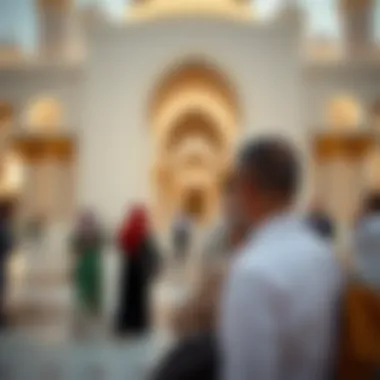
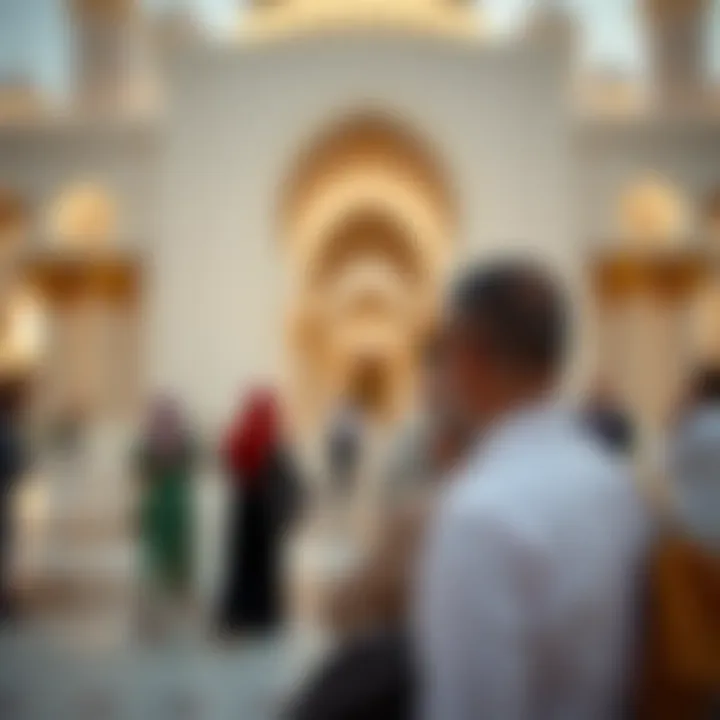
- Sheikh Zayed Grand Mosque: Known for its stunning white marble structure and intricate floral designs, it also features 82 domes, making it one of the largest mosques in the world. The combination of traditional Islamic architecture and modern technology creates a unique atmosphere that resonates with local culture.
- Al-Aqsa Mosque: This mosque offers historical significance and is renowned for its sacred status within the Islamic world. The use of ancient materials and design reflects the rich history of Jerusalem.
While Dubai’s mosque incorporates modern design elements and innovative construction techniques, its regional counterparts often represent more traditional styles and methods. This contrast emphasizes Dubai's willingness to marry functionality with modern aesthetics, making a statement about contemporary Islamic architecture.
Global Perspective
Moving beyond the region, comparing Dubai’s mosque with other global icons can provide insights into the evolution of mosque architecture.
- Hassan II Mosque in Morocco: Positioned partially on the ocean, this mosque boasts the tallest minaret in the world. Its stunning design and ability to accommodate thousands positions it as a cultural landmark, similar to Dubai's mosque, which also embodies grandeur.
- Sultan Ahmed Mosque in Istanbul: Affectionately known as the Blue Mosque, its harmonious blend of Byzantine architecture with certain Islamic elements has provided a foundational piece for mosque design. The Dubai mosque, while distinct in its modern approach, reflects a similar grandeur through its towering structure and meticulous detail.
As these comparisons suggest, architectural trends can differ vastly depending on cultural heritage and the modern context of construction. Each mosque, whether it’s in the Gulf or further afield, tells a story of its own time and place while also contributing to the collective narrative of Islamic architecture.
In essence, the comparative analysis reveals not only the uniqueness of Dubai’s largest mosque but also underscores a shared commitment within Islamic architecture to create spaces for worship that inspire and unify.
Through understanding our regional and global counterparts, we gain deeper appreciation for the innovation and artistry that marks our sacred spaces.
For further exploration of Islamic architecture, you might want to check out resources at Wikipedia or Britannica. It can widen your view on this rich and diverse field.
Future Developments and Innovations
The horizon promises not just growth but a fascinating transformation for Dubai's largest mosque. This section highlights potential expansions and technological integrations that could enhance its status as both a religious and cultural landmark. The mosque stands as a symbol of architectural prowess; yet, the future holds even greater possibilities. As urban landscapes evolve, so does the role of such significant structures. The mosque aims to adapt to modern requirements while preserving its traditional essence.
Potential Expansions
Considering the increasing number of visitors and expanding community needs, future expansions might include:
- Visitor Center: An interactive space that provides educational resources about the mosque's architecture and Islamic teachings.
- Outdoor Spaces: Additional gardens or public squares to enhance community interaction and gatherings.
- Cultural Halls: Areas dedicated to art exhibits and Muslim culture presentations, creating an engaging environment for both locals and tourists.
These expansions wouldn't only make the mosque more accessible but also allow for a greater engagement with the surrounding community. Enhancing facilities for events and educational programs means the mosque could play a larger role in cultural exchange.
Technological Integrations
The infusion of technology adds another layer of innovation to the mosque's design. Some potential integrations include:
- Smart Lighting Systems: Energy-efficient lighting that adjusts according to natural light and weather conditions, adding to the aesthetic experience.
- Virtual Tours: Through augmented reality applications, individuals could explore the mosque from anywhere in the globe, expanding its reach beyond physical boundaries.
- Sustainable Technologies: Solar panels and water recycling systems that not only contribute to sustainability but also align with Islamic teachings about stewardship of the Earth.
Through these advancements, the mosque will not just maintain its relevance but also elevate its status as a model of contemporary mosque design. Integrating technology thoughtfully can enhance the viewer experience while staying true to its cultural and historical roots.
"The future of sacred spaces lies in their ability to adapt to modern needs without losing their essence."
End
The conclusion is a crucial part of any piece, especially when discussing a structure as significant as Dubai's largest mosque. It serves not just to summarize, but to encapsulate the essence of what's been laid out in previous sections. This mosque represents a unique blend of tradition and modernity—establishing it as a vital part of Dubai's cultural tapestry.
Reflections on Cultural Significance
Reflecting on the cultural significance of the mosque, one cannot overlook the way it stands as a symbol of faith and community. It is not merely a place for worship; it’s an embodiment of Islamic values, promoting peace and understanding. Locals and tourists alike find sanctuary within its walls. It also serves as a venue for various cultural events, which enriches Dubai's social fabric.
Moreover, the mosque encourages a dialogue between cultures. In today’s globalized world, it plays an important role in presenting Islam’s rich heritage to non-Muslims. This aspect fosters curiosity and opens pathways for understanding among different faiths. The respect shown to the mosque from visitors highlights its importance in bridging cultural gaps. Understanding its cultural weight enables us to appreciate why it is more than just a building.
The Mosque's Role in Dubai's Future
Looking ahead, the mosque's role in Dubai's future can’t be understated. As Dubai continues to evolve as a global hub for tourism and finance, the mosque is set to be a salivating point for visitors, drawing attention not just for its size but for its significance. Its architectural grandeur will help spur further interest in Islamic architecture, making it an educational resource for future generations.
Furthermore, as the city embraces innovation, the mosque can set an example in sustainable practices. Adopting eco-friendly technologies and materials in its operations might just inspire neighboring structures to follow suit, perfectly aligning with Dubai's ambition of being an environmentally aware city.
In sum, the mosque is not only a testament to the emirate's rich Islamic heritage but also a beacon of identity and future aspirations for Dubai. Emphasizing both tradition and progress, it is poised to lead by example in fostering community engagement and cultural appreciation.







